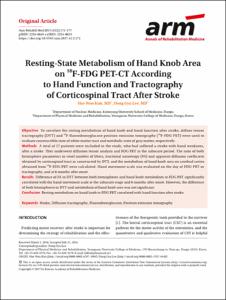KUMEL Repository
1. Journal Papers (연구논문)
1. School of Medicine (의과대학)
Dept. of Nuclear Medicine (핵의학)
Resting-State Metabolism of Hand Knob Area on 18F-FDG PET-CT According to Hand Function and Tractography of Corticospinal Tract After Stroke
- Keimyung Author(s)
- Kim, Hae Won
- Department
- Dept. of Nuclear Medicine (핵의학)
- Journal Title
- Annals of Rehabilitation Medicine
- Issued Date
- 2017
- Volume
- 41
- Issue
- 2
- Abstract
- Objective :To correlate the resting metabolism of hand knob and hand function after stroke, diffuse tensor tractography (DTT) and 18F-fluorodeoxyglucose position emission tomography (18F-FDG PET) were used to evaluate constructible state of white matter tract and metabolic state of gray matter, respectively. Methods: A total of 17 patients were included in the study, who had suffered a stroke with hand weakness, after a stroke. They underwent diffusion tensor analysis and FDG PET in the subacute period. The ratio of both hemisphere parameters in voxel number of fibers, fractional anisotropy (FA) and apparent diffusion coefficient obtained by corticospinal tract as constructed by DTT, and the metabolism of hand knob area on cerebral cortex obtained from 18F-FDG PET were calculated. Hand movement scale was evaluated on the day of FDG PET or tractography, and at 6 months after onset. Results: Difference of FA in DTT between both hemispheres and hand knob metabolism in FDG PET significantly correlated with the hand movement scale at the subacute stage and 6 months after onset. However, the difference of both hemispheres in DTT and metabolism of hand knob area was not significant.Conclusion: Resting metabolism on hand knob in FDG PET correlated with hand function after stroke.
- Keimyung Author(s)(Kor)
- 김해원
- Publisher
- School of Medicine
- Citation
- Hae Won Kim and Dong Gyu Lee. (2017). Resting-State Metabolism of Hand Knob Area on 18F-FDG PET-CT According to Hand Function and Tractography of Corticospinal Tract After Stroke. Annals of Rehabilitation Medicine, 41(2), 171–177. doi: 10.5535/arm.2017.41.2.171
- Type
- Article
- ISSN
- 2234-0646
- Appears in Collections:
- 1. School of Medicine (의과대학) > Dept. of Nuclear Medicine (핵의학)
- 파일 목록
-
-
Download
 oak-2017-0021.pdf
기타 데이터 / 292.47 kB / Adobe PDF
oak-2017-0021.pdf
기타 데이터 / 292.47 kB / Adobe PDF
-
Items in Repository are protected by copyright, with all rights reserved, unless otherwise indicated.